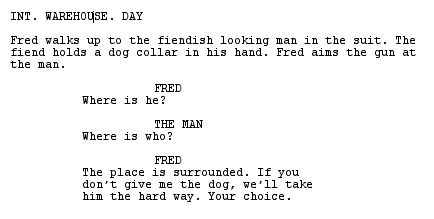Format
In order to gauge more or less how long a film a script will make (very useful for producers), there are certain standards in formatting. Avoid these at your own risk. Americans especially are very rigid about this. These standards allow us to measure a script’s length by saying that: “a page of script equals roughly a minute of screen time”. This is a very rough guide (often action films scripts are short but take longer on screen than a dialogue based script) and not to be completely trusted.
Font
You should use Courier (or New Courier) Size 12. This is a fixed-width font, which many believe makes it easier to read. You’ll be surprised how picky some readers are about this.
Length
Should fall between 90 to 120 pages. Anything longer and your chances of being read begin to diminish. Dumb huh?
Numbering
Avoid numbering scenes unless it is a shooting script which will only be seen by yourself or when actually shootingthe film. Script readers don’t like them.
Layout
A script layout should look something like this. Some will demand exact measured layouts but few are very sticky about exact distances from margins etc. (Note that it is difficult to display exact layouts on web browsers – this is only a rough guide.)
Layout Example
Dialogue
This one is a toughie. It’s very hard to teach dialogue. One has to develop an ear for the way people really speak and not how we think they speak. Listen to people from various backgrounds and in various situations talk as often as you can. You’ll probably notice that people are not very eloquent in general. They don’t express themselves very well vocally and a great deal of what is NOT said is just as important (often more so) than what is said. Bring these thoughts to your scriptwriting process. And again read lots of scripts and watch many films to become more sensitive to dialogue.
An important thing to remember is that scripts are the basis of the visual medium of film. An old adage is: never say what you can show instead. In other words if a character is angry don’t have her say “I’m angry!”, show it to us. E.g. have her smash a window with a chair instead.
Characters
There is almost always a central character in a Hollywood movie. That is because Hollywood films work on the basis of the audience being able to identify with a character and his or her experiences. More than one central character tends to confuse the viewers (at least according to many studio execs).
Characters are expected to be three dimensional and rounded. By that it is meant that we should get a sense of their history and how it has affected them as well as understanding why they do what they do (usually called Motivation). (E.g. X avoids men because of a previous heartbreaking episode). This is based on the idea that we do things for knowable reasons. Modern psychology came up with this somewhat naïve notion. However we rarely actually have access to the full reasons why we, others (or ourselves) do what we do. Nevertheless Hollywood believes otherwise.
This convention often leads to some awfully contrived scenes in which characters reveal really corny back-stories and traumatic past events. This is also called “exposition” and is very difficult to write without being obvious or corny. Exposition should happen organically and without the audience realising it. Some filmmakers such as David Cronenberg don’t allow us to get close to their characters and we rarely know why they do things except for the obvious. Unlike in most Hollywood films we are not participants in Cronenberg’s films – but voyeurs watching the action from the outside.
Nevertheless it often helps to create back-stories for your characters. These are basically histories for your characters – their life experiences, social and economic background etc. This doesn’t have to all be obviously present in the script but helps to craft more real characters.
Part of having a three dimensional character is that we see him or her develop across the course of the script. They should change in front of our very eyes. Again remember these are all conventions for a conventional style of film.
Camera Directions
It’s usually not appreciated that you include camera movements in your scripts. There are ways of getting around this in sticky situations. Sometimes it can’t be avoided. Tarantino’s scripts on the other hand are full of camera directions. If the script is going to be pitched to outside producers and script-reader
